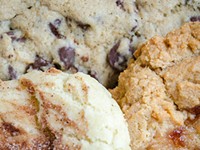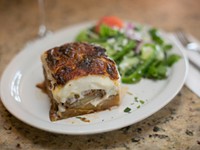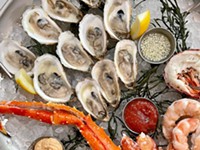[
{
"name": "500x250 Ad",
"insertPoint": "5",
"component": "15667920",
"parentWrapperClass": "",
"requiredCountToDisplay": "1"
}
]
In 2009, Chef San Lee made a clean break with the past, closing his successful restaurant China Garden in Henrietta and, as his son Brandon put it, "taking a break" from more than 30 years of restaurant cooking. The chef took a vacation and started to consider what he wanted to do next. The elder Lee never set out to be a chef at all. In his youth in China he had trained to be an engineer. It was only when he emigrated from China, following his brother to the United States, that he found himself working in a restaurant kitchen. He learned, and then perfected, the American canon of kung pao chicken, sweet-and-sour sauce, shrimp in garlic sauce, and all the variations on General Tso's chicken.
Chef Lee's newest restaurant, Chakara Bistro & Bar, in Fairport is in many ways an homage to that cuisine — but it is also a radical departure from it. Chakara is Lee's attempt to invert the American-Chinese menu by making it more Chinese-American, reinventing Chinese food for a generation of diners who are more adventurous and more urbane than their grandparents, the generation for whom American-Chinese food was developed.
Look closely at the menu at Chakara and you will see what I mean. At first glance, the compact menu doesn't look familiar. But start parsing ingredients and things jump out at you. Kurobuta honey pig ($12), for instance, sounds pretty exotic. Add up the ingredients, though — pork loin, pineapple, and bell peppers in a "sweet tangy sauce" — and what you have is sweet-and-sour pork. Tiger shrimp rolls ($5) — deep fried and filled with goat cheese and ground shrimp, served with a sweet, fragrant dipping sauce — are a riff on crab rangoon. Mongolian beef ($13), served over handmade spinach noodles, benefits from an agreeable — and surprising — black-bean sauce funkiness. Chicken in garlic sauce ($14) looks very familiar, too; a colorful stir-fry with julienned carrots, shredded celery, broccoli, and snow peas. But the secret is in a sauce enriched with nearly scandalous amounts of garlic, a bit of burnt orange peel, and just a whisper of Szechuan peppercorn to wake up the palate. Your grandmother would recognize the dishes, but the flavors would probably take her by surprise.
Chef Lee, though, doesn't stop at his reinterpretation of the American-Chinese canon. He also expands on it, casting a wide net that encompasses curries and stir fries from Thailand; a bit of hibachi-style cooking, gyoza, edamame, and seaweed salad from Japan; and a wide swath of popular Vietnamese dishes, including papaya salad, fresh spring rolls, and pho. He even throws in some pretty amazing bread and pastry work.
You can get pad Thai at Chakara, but unless you are paying attention you might not realize that mee Siam ($12) is the name of that spicy-smoky assembly of rice noodles, shrimp, bean sprouts, egg, and chicken. The first time we ordered it, we were pleasantly surprised and a bit perplexed when our server delivered the dish, and then delighted when we discovered that it was an exceptional example of its kind — the spice layered on with a judicious hand to deliver something savory but not overwhelming. I can honestly say that it was the first pad Thai I've ever had where I could taste something other than the sauce and actually appreciate the noodles and other ingredients.
Brandon Lee, who manages the front of the house while his father holds down the kitchen, maintains that part of the mission of his restaurant is to offer a lighter take on pan-Asian food. But my hands-down favorite item on the menu at Chakara is the butternut-crab curry ($19), two meaty and just slightly crunchy soft-shelled crabs stir-fried with tomato, scallion, and tender butternut squash and finished with an amazingly complex curry sauce mounted with coconut milk. The dish is almost too pretty to eat, and the primal pleasure of dismembering and then biting through the shells of the crabs is not to be missed. Usually I ignore my rice, but with this dish I considered asking for more so that I wouldn't have to give up even a molecule of the delicious sauce.
On our first visit to Chakara, we took a winger on an odd-sounding dish of Malaysian bread with a curried dipping sauce ($4) as an appetizer. Again, Chef Lee surprised me: his "Malaysian bread" is in fact a wide, flat croissant — flaky, buttery, and utterly delectable with a peppery curry sauce to cut through all of that fat. The same bread acts as a platform for a dish that the menu simply calls "China" ($15) — beef braised in "13 spices" along with leeks and scallions, which arrives at the table in a gust of fragrant steam. By the end of the meal, I had abandoned decorum altogether and used the round bread as a kind of bastard pita or gordita shell, wolfing down tender beef and allium and then mopping the plate. (Incidentally, the tiny bit of the bread that remained made an equally excellent sop for the crab curry sauce, too.)
On my final visit to Chakara, I was forced to bring my 7-year-old dining companion along with me (if you happen to know a good sitter, do contact me). Normally, I would hesitate to bring him along to a place as swanky as this — white tablecloth joints and small fry don't tend to mix well. I need not have worried. Former lab assistant and now head waiter Andrew Patterson provided service that was so well paced, efficient, and friendly that I was convinced he could read my mind, and that of my kid, about half the time. Even if Chef Lee's food weren't stellar (it is, though), the quality of Patterson's service could almost carry the weight of the entire restaurant.
Latest in Dining Reviews
More by James Leach
-

DINING REVIEW: Orange Glory Cafe
May 15, 2013 -

Dish 2013: Updating the kiddie menu
May 8, 2013 -

DINING REVIEW: Opa Authentic Greek Koozina
May 1, 2013 - More »



